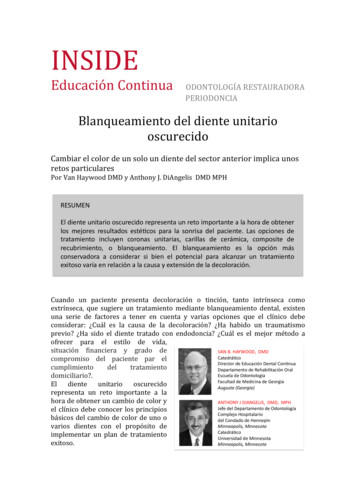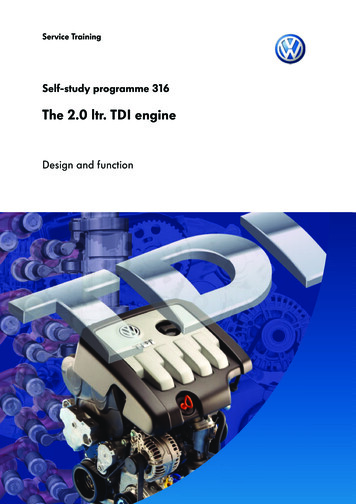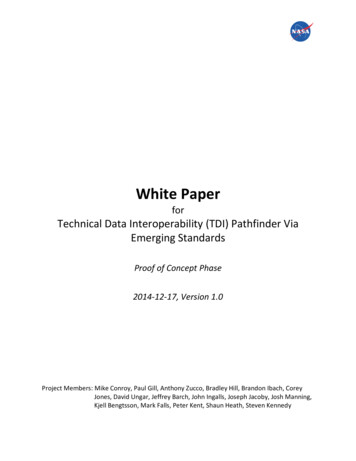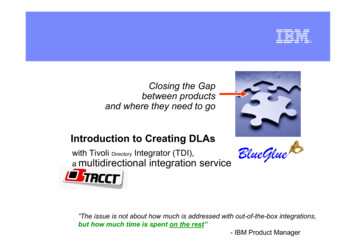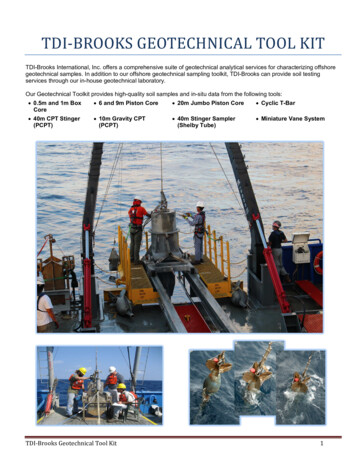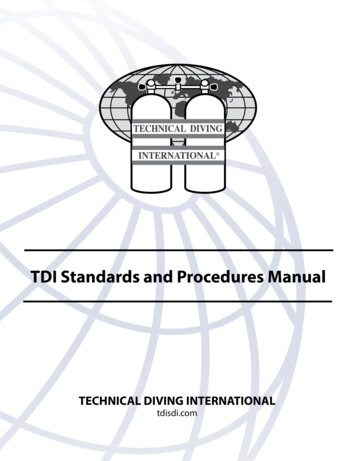
Transcription
TDI Standards and Procedures ManualTECHNICAL DIVING INTERNATIONALtdisdi.com
TDI Standards and Procedures Manual:Publisher: International TrainingPhone: (888) 778-9073 Fax: (877) 436-7096tdisdi.com worldhq@tdisdi.comCopyright 1994 by Technical Diving International (TDI) v.0122Notice of Rights: All rights reserved. No part of this book may bereproduced or transmitted in any form by any means, electronic,mechanical, photocopying, recording, or otherwise without the prior writtenpermission of the publisher. For information on getting permission forreprints and excerpts, please contact International Training.Trademarks: Scuba Diving International , Technical Diving International and Emergency Response Diving International are registered trademarks ofInternational Training.ISBN: 1-931451-88-5Product ID #: 120100-01
part1introductionIntroduction
TDI Standards and ProceduresPart 1: IntroductionContents1. Instructor Package. 92. A Brief History. 103. Code of Ethics and Conduct. 134. Introduction. 15 4.1 You and TDI.155. Using Your Instructor Manual. 16 5.1 Purpose.16 5.2 How to Use This Manual.166. TDI - Professional Dive Instruction. 18 6.1 The Need for Standardized Instruction .18 6.2 The Role of the Instructor.19 6.3 Becoming a Great Instructor .20 6.4 Risk Management.21Version 01223
TDI Standards and ProceduresPart 1: Introduction7. TDI General Membership Standards. 30 7.1 General.30 7.2 Regional Office Affiliation Procedures.31 7.3 Active Teaching Status.32 7.4 Probation Status.32 7.5 Non-Teaching Status.32 7.6 Suspended Status.33 7.7 Expelled Status.33 7.8 TDI Quality Assurance (QA) Procedures.33 7.9 Required Subject Area for all Instructor Courses.36 7.10 Definitions.36 7.11 Forms.37 7.12 Exams.37 7.13 Existing CCR Instructor - Unit Crossover/Upgrade.37 7.14 Requirements for Dive Leader Crossovers.38 7.15 Two Year Renewal/Refresher Policy.394Version 0122
TDI Standards and ProceduresPart 1: IntroductionRevision .102/04/2002Minor updates2.210/10/2002Updated with latest Training Updates.3.008/15/2003Updated with latest Training Updates.3.112/19/2003Editorial changes and minor updates.5.011/19/2004Editorial changes and minor updates.6.010/13/2005Updated with 2005 training updates7.010/27/2006Minor changes8.011/13/2007Updated with 2007 training updates9.012/01/2008Clarifications and updated language added10.012/31/20092009 Updates & Minor Edits11.001/01/2011Minor edits and formatting12.001/01/2012Minor edits13.001/01/2013No Changes14.001/01/2014No Changes14.104/01/2014Added directions to the Two Year renewal process for DM's, AI's andSupervisors15.001/01/2015No Changes15.104/01/20157.2 Added International dive leader registration procedures7.12 Updated Rebreather Instructor Crossover requirements15.208/01/2015No Changes15.311/01/2015Page Two: Headquarters information updated1. Removed insurance contact information as well as headquarters'address and business hours16.001/01/2016No Changes16.14/01/2016Added new 7.14 Requirements for Dive Leader Crossovers16.207/01/2016Added 7.3.7 requiring annual medical for Dive Leader RenewalVersion 0122Changes5
TDI Standards and ProceduresPart 1: IntroductionRevision History6RevisionNumberDate17.001/01/2017No Changes17.102/24/2017Updated 7.13 CCR Instructor crossover/upgrade requirements18.001/01/2018Removed 7.3.7 requiring annual medical for Dive Leader Renewal19.001/01/20196.4.8 Added new section, renumbered subsequent section7.1.7 Clarified wording7.8.6 Step 4 – removed last sentence7.13.4 Clarified unit crossover/upgrade requirements7.15.1d added update for blender and service technician instructorratingsFormatting updated012001/01/20207.14 Section replaced with updated text7.15 "Note" Expanded upon012101/01/2021No Changes022102/01/2021No Changes012201/01/2022No ChangesChangesVersion 0122
TDI Standards and ProceduresPart 1: IntroductionVersion 01227
TDI Standards and ProceduresPart 1: Introduction8Version 0122
TDI Standards and ProceduresPart 1: Introduction11. Instructor PackageThis package contains all pertinent information necessary to do business as aTDI Instructor.Please retain this package as a handy reference guide. Forms may becopied as needed to process orders, register students, etc. We recommendedthat you keep the originals intact and use them as master copies when youneed them.World Headquarters:Technical Diving InternationalToll Free:888-778-9073Fax:877- 436-7096E-mail:worldhq@tdisdi.comWeb site:tdisdi.comOrders or registrations can be faxed 24 hours a day.Our staff of dive professionals will be happy to handle your businessneeds, questions or concerns. We appreciate your business and look forwardto giving you the best service we possibly can!Version 01229
TDI Standards and ProceduresPart 1: Introduction2. A Brief HistoryFrom its humble beginning in 1994 to today, the group of training agenciesknown as Scuba Diving International (SDI), Technical Diving International(TDI), and Emergency Response Diving International (ERDI) form one ofthe largest certification agencies in the world. With offices servicing morethan 100 countries, the company today far exceeds the original visionthe founders had when they conceived the idea on a napkin, sitting at thekitchen table many years ago.As with many companies, the original concept for the business was anoutgrowth of the recognition that a niche needed to be filled. This nichewas providing specialized training for what the industry now calls technicaldiving, and the founders did so by forming the first agency of the group,Technical Diving International, in 1994.Technical Diving International was one of the first agencies of its kind.It focuses on providing training materials and education in special areasranging from Nitrox to Closed Circuit Rebreathers (CCR), along withoverhead environments such as Cave and Wreck diving. TDI also providestraining in the preparation of gas mixtures for dives up to 100 meters (330feet).During TDI’s development, there were a few key things that separated itfrom its competitors and pioneered the way many divers learn to dive today.For one, TDI was at the forefront of the movement that convinced the diveindustry to accept technical diving activities. In the early stages of technicaldiving there were many industry professionals who felt the average diverwas not smart enough to handle the expanded dive planning that goes intodoing a technical dive, and that technical diving was far too risky for nonprofessionals. These two factors were offset at TDI by an extensive educationprocess conducted through seminars, publications, and TDI’s trainingmaterials. The average diver realized that the risk in technical diving couldbe brought to an acceptable level and they were indeed smart enough toconduct technical dives. Today, the industry not only embraces technicaldiving, but Nitrox is now the largest specialty course taken worldwide.Another key event in TDI’s history occurred when it became the firstagency to pioneer the use of Semi Closed Rebreathers by recreational divers.This opened the door to allow divers to use Closed Circuit Rebreathersrecreationally and spawned a whole new segment of the dive industry. Inshort, TDI ushered in an exciting breakthrough in the dive industry thatmany believe actually prevented the industry from further decline.10Version 0122
TDI Standards and ProceduresPart 1: IntroductionIn 1998 the membership of TDI could no longer be held back from theirdemands for creation of a sport diving division of TDI and thus was bornScuba Diving International (SDI). The primary reason for this expansionwas that dive instructors enjoyed dealing with an agency that listened to theinstructors in the field and created programs that were, and continue to be,very profitable because they are tailored to the way today’s diver wants tolearn to dive.Like TDI, SDI did a number of things that separated it from previouslyestablished training agencies. One example is that SDI was the first agencyto require the use of personal dive computers by all divers during everydive. This new standard was put in place because dive computers wereand are used daily by all diving professionals to make diving safer andmore enjoyable. Research showed that the average diver forgot how touse dive tables soon after completion of a course. This fact, along withthe advancement and increased reliability of dive computers, meant theywere considered a safer alternative to dive tables. SDI recognized this andalthough dive tables are not required curriculum in the basic diver course,they still can be taught during any course.Another ground breaking step taken by SDI was the development ofan e-learning platform for dive education. Allowing a student to learn theacademic portion of a dive course online rather than requiring additionalclassroom instruction was a bold yet visionary step. Currently SDI is one ofonly a few agencies that offer divers the opportunity to learn online and isthe only organization to offer continuing education courses.With the membership now happy about their options for both sport andtechnical dive training through SDI and TDI, they continued to ask for morespecialized training in public safety, and thus Emergency Response DivingInternational (ERDI) was born in 2000. ERDI was and continues to be theonly training program that is supported by a major certification agencycatering exclusively to public safety diving. Throughout the years ERDI haswritten programs that have trained very established dive teams such as theChicago Fire Department, numerous state police dive teams, and also severalfederal agencies.In 2004, with 10 years of development into the company, the foundersof SDI/TDI/ERDI decided it was time to move on and sold the company toa group of investors who quickly expanded the offerings of the company.Immediate changes included applying for and receiving acceptance intothe Recreational Scuba Training Council (RSTC) and the EuropeanUnderwater Federation (EUF). This acceptance was critical because it meantthat SDI standards were evaluated and found to be sound and safe by itsVersion 012211
TDI Standards and ProceduresPart 1: Introductioncompetitors. SDI passed with ease and today is currently actively involvedin both organizations, helping make the sport safer for more divers. Otherchanges came with additional staff and a commitment to embrace electronictechnologies to make doing business easier for members.Although SDI/TDI/ERDI is considered to be one of the newerorganizations in the industry, it is viewed as one of the most professional andprogressive certification agencies. SDI/TDI/ERDI’s history and its reputationas an innovator have built a strong foundation for the future. By listening toits members and building programs that are profitable and keep risk at anacceptable level, the future is bright for the organization.12Version 0122
TDI Standards and ProceduresPart 1: Introduction3. Code of Ethics and Conduct Technical Diving is recognized as an advanced form of SCUBA diving,and as such carries with it a degree of risk and responsibility not normallyassociated with recreational diving. We believe an individual should not be qualified as a TDI Diver unlessthose em powered to qualify the person would allow them to buddy or toteach their loved ones technical diving. The TDI Technical Professional always maintains their personal, physical,and mental fitness as they relate to diving. The TDI Technical Professional always maintains their life supportequipment and never begins a dive with defective equipment. The TDI Technical Professional strives to maintain an attitude ofprofessionalism and objectivity, and supports the concept of safety intechnical diving. The TDI Technical Professional will not encourage or recruit otherindividuals to dive technically if unqualified. The TDI Technical Professional will make every effort to pass on theirknowledge to novice technical divers and the diving community ifrequested to do so, whether through formal instruction, answeringquestions or via appropriate publication in books, journals and magazines. The TDI Technical Professional recognizes that they have access to a newdimension and depth of underwater exploration and strives to encourageand practice an awareness of conservation of the underwater environmentat all times. The TDI Technical Professional, by virtue of their voluntary membershipin TDI, recognize a responsibility and obligation to promote TDI andsupport the official decisions and policies adopted by TDI. In fulfilling thisobligation to the organization, the TDI Divers and Instructors shall:a. Publicly support TDI as an organization.b. Make every effort to bring about necessary changes in aprofessional manner by direct contact with those fellow TDIMembers and Divers who are in positions of authority andresponsibility. Publicly support TDI as an organization. Make every effort to bring about necessary changes in a professionalmanner by direct contact with those fellow TDI Members and Divers whoare in positions of authority and responsibility.Version 012213
TDI Standards and ProceduresPart 1: Introduction Every TDI Member has an obligation to report violations of TDIStandards of the Code of Ethics / Conduct. Every TDI Member should strive to set an example of professionalbehavior and ethical conduct in all activities including, public speaking,articles and books, and various forms of Internet style discourse. Unwarranted critical comment and de liberate inflammatory statements ofdiving peers is inappropriate and undesirable.14Version 0122
TDI Standards and ProceduresPart 1: Introduction4. IntroductionStandards that ensure genuine diver safety while maximizing the pleasuresof learning to dive are the foundation of TDI’s diver training programs.TDI has re-examined limits that are arbitrary or based solely on traditionand developed new guidelines using scientific data and common sense. TDIbelieves divers should be trained from the beginning to take advantage ofnew technologies and enjoy the freedom to dive deeper or longer or both with greater safety.As skill and experience increase, TDI offers divers training that willallow them to advance beyond the traditional limits of recreational diving tothe level of skill they desire.4.1 You and TDIAs an instructor, your role in the TDI family is the most important of all.You are the ambassador who will deliver enlightened and innovative scubainstruction to divers. Your ideas and experiences are a vital part of TDI’sgrowth and we value your input to help keep us on the leading edge. You arealso encouraged to continue your career as an instructor by also becomingcertified as an SDI Instructor to teach sport diving programs such as the SDIOpen Water Scuba Diver, Advanced Adventure Diver and Rescue or moveinto emergency response diving with ERDI if you have not done so already.You are already a qualified diver or you wouldn’t be here. Our job isto provide you with the tools to transfer that knowledge to students. Theywould be overwhelmed if they tried to absorb, in one course, even a part ofthe knowledge you have gained throughout your career. Therefore, it is vitalthat we be selective and make sure that new students receive the trainingthey actually need. This open water body of knowledge is so vital that TDIhas focused a great amount of research and effort to determine whichknowledge and skills are most important.TDI will help you select the information that is most vital to studentsand show you proven ways to teach them. It’s up to you to use your abilitiesas an instructor to deliver this critical core package to the student. It’s apartnership between TDI and YOU.Version 012215
TDI Standards and ProceduresPart 1: Introduction5. Using Your Instructor Manual5.1 PurposeYour TDI Instructor Manual is intended to be your guide to providing safeand enjoyable training to divers from the open water level to black water,cave and Trimix CCR. It is your reference for the standards and proceduresthat TDI instructors implement to achieve consistency and quality. Itoutlines the vital “core knowledge” that each of your students needs toachieve TDI certification. Finally, but no less important, it is intended to helpyou effectively deliver the skills and knowledge your students will actuallyneed.Your TDI Instructor Manual is meant to be a “living manual” - updatedon a regular basis, it is meant to grow and change with you throughout yourdiving career. From time to time you will receive updates for your manualand you should be sure to incorporate these updates promptly so that yourmanual is always up to date.5.2 How to Use This ManualYour manual has intentionally been kept brief but concise.In fact, you’re already reading the first section, the Introduction, whichintroduces you to the TDI concept of dive instruction. The manual consistsof several parts. These parts are:1.2.3.4.IntroductionDiver StandardsLeadership StandardsFormsPart 1, Introduction covers: The Need for Standardized Instruction.Explaining TDI’s progressive approach to consistency and excellence ininstruction. The Role of Instructor.Emphasizes your important role in the TDI family. Risk Management.Directs you to further information to protect yourself against a problemthat could consume your career. Of course, you want to be the bestinstructor possible, so,16Version 0122
TDI Standards and ProceduresPart 1: Introduction Tips to Becoming a Great Instructor.Tips that offer information that can help you be a better teacher and arespected professional in dive instruction.Part 2, Diver Standards covers: The list of the current Diver Courses offered through TDI.Part 3, Leadership Standards covers: The list of the current Leadership Courses offered through TDI.Part 4, Forms covers: The list of the current forms used by and required by TDI.Version 012217
TDI Standards and ProceduresPart 1: Introduction6. TDI - Professional Dive Instruction6.1 The Need for Standardized InstructionEarly in the history of scuba instruction, experienced divers simply tooknovice divers under their wing and taught them what they felt they neededto know to be a “skin diver”. There were many accidents and diving gaineda reputation as a dangerous sport. Scuba diving “clubs” were organizedand began to develop standards for safe diving. Eventually, a large bodyof safe diving practices was developed as diving knowledge expanded.Professional training agencies were created and they sanctioned instructorsto “certify” the divers they trained. This was an improvement over the era of“no standards”, but, there was wide variation in what knowledge and skillsinstructors thought their students should learn. Methods of instructionranged from military style to “sink or swim”.If scuba was to become safer and appeal to the general public, furtherchanges needed to be made. Scuba needed to lose its macho image andpunishing physical demands. A core of knowledge essential for safe andenjoyable diving had to be identified and standardized. Most difficult of all,uniform and consistent methods of instruction were needed so studentscould actually learn the real world knowledge and skills they needed to safelyenjoy diving. TDI’s recognition of the importance of uniform standardsand consistent instruction forms the foundation of this manual. If TDIinstructors are to be successful in teaching students what they need to know,then they must know what to teach and, just as importantly, they must knowhow to teach it.Instructors are individuals, and as such, they will naturally haveindividual teaching styles. It is TDI’s goal to grant you the freedom to projectyour own style and personality into your teaching, provided your studentsare exposed to the same core knowledge and proven methods of instructionas all other TDI students. It is this concept of a carefully chosen body ofknowledge delivered consistently with a proven method of instruction that isreflected in the TDI instructor certification course.Several benefits are obvious when you use a standardized course contentand method of instruction such as: Since the course structure is standardized, you can focus on moreimportant things like individual student needs, etc. You are less likely to be drawn into the trap of spending too much timeon some topics at the expense of others. Naturally, students judge a topic’simportance by the amount of time you spend on it.18Version 0122
TDI Standards and ProceduresPart 1: Introduction You are less likely to entirely omit teaching something important. In the event of a lawsuit, your actions can be more successfully defended ifyou have instructed your students using a proven, standardized programdeveloped by a respected international dive instruction agency. Your presentations will look far more practiced and professional. You will look more professional, and you will be.6.2 The Role of the InstructorOK, so there are tremendous benefits to instructing using the TDIcurriculum and methods of instruction, but what’s left for you the instructorto do? Plenty! Even the best program of instruction is only as good as thepeople who present it. Why? Because even though your curriculum may beefficient and predictable, your students and diving environment are not! Youwill be the only one in the course with the training, experience, and judgmentto put it all together. As an instructor, only you can combine these threeelements into a safe and enjoyable, high quality learning experience!Beginning with the decision to start an open water class, you must makea series of judgment calls: How big will the class be and how much help will you need? Who will be in your class and what mix of ages (10 - 72?)? Are there health issues (heavy smoker needs release)? Will relationships (controlling parent, hovering significant other) interfere? What atmosphere will you teach best in? Will you incorporate videos or primarily lecture? How will you blend the online learning and classroom sessions? Will you take them to water early and risk overwhelming someone or lateand risk losing their interest? How do you know who really understands and how can you help thosewho don’t? Who’s likely to panic in open water and how will you protect them? Do you certify the marginal student?It’s up to your judgment! It’s obvious that even with the solid base of TDI’sbalanced curriculum and proven teaching methods, the most importantfactor in teaching open water students is you.Version 012219
TDI Standards and ProceduresPart 1: Introduction6.3 Becoming a Great InstructorA great instructor is first of all a professional. Think about the people you most admirein almost any aspect of life and it is likely that they share many highly professionalcharacteristics. In dive instruction, professionalism is so vital to both our success andour safety that it is important that we each ask the question - what are the hallmarksof a professional? A professional acquires the knowledge and skills necessary to offer and attractbusiness - i.e. the business of scuba diving. A professional keeps abreast of the latest technology and changes in his/herprofession. A professional charge a fee for services rendered. A professional endeavors to be open-minded and fair. A professional is a member of a self-policing organization. A professional is a role model who: Is physically fit. Is ethical. Has a positive attitude. Shows consideration for others (i.e. is on time).No one is “born” a professional and it doesn’t usually “come naturally” either. Formost of us, becoming a professional takes hard work and long term commitment to aset of quality goals. Just as important, remaining a professional means a career-longcommitment to supporting the best principles of your profession - while remainingopen to new ideas and technology. The most challenging parts of being a professionalinstructor have little to do with scuba diving. For most of us, the real challenges aremore closely related to the personal aspects of human relations; patience, tolerance,self-control, a willingness to deal with our own feelings and the ability to embracechange. Change is inevitable. It is sometimes fun, often painful and usually expensive. Sinceit will occur in our industry as in others, we must learn to make the very best of it. If a new idea is good, then why not be a part of it. If we believe a new idea is not good, then we should argue honestly and resistreasonably. If we are right, a poor idea will disprove itself and go away. Count on change happening - that way you won’t be disappointed. If you have a better idea – then act on it and make change happen yourself!Our own feelings can create a world of trouble for us. We won’t always like thepeople or situations we deal with and that can affect our behavior in destructiveways. Sometimes we don’t even know it is happening! Therefore it is vital to try torecognize, be honest about and deal with, our own feelings. The goal is to emergefrom the situation self-satisfied and productive.20Version 0122
TDI Standards and ProceduresPart 1: IntroductionSelf-control is essential to professionalism. We all have strong feelings andemotions about some issues, but your students will look to you for balanceand common sense. Avoid extremes of behavior or opinion and do notpublicly criticize your competitors or your students. You will harm yourselfmore than them.Tolerance is a sign of maturity and experience. Professionals are expected todeal with “all kinds” of people. Many will not be as sensible or well roundedas you, but that’s one reason why you’re the instructor.Patience is a trait shared by the greatest teachers. People learn in differentways and at different speeds. If you move too slowly, you may bore someof your students, but, if you move too fast, you will lose others altogether.More importantly, if you appear impatient with your students’ progress, youare likely to embarrass them. They may lose their ability to concentrate andultimately resent you and scuba diving. If you are patient, most will becomecompetent divers, enjoy themselves and respect your professionalism.6.4 Risk Management6.4.1. Teaching DefensivelyProbably the single best advice an instructor can follow is to "expect theunexpected". In other words, never assume that everything will go rightor as planned. You should never take for granted that all directions youconvey will be followed. Since diving instruction began back in the 1960s,prudent instructors have made it a practice to always presume their studentswill suddenly divert into behavior exactly opposite to what has beenbriefed; therefore, they try to continuously think ahead to the countlesscontingencies that may be spontaneously presented and plan how to quicklyrespond in order to prevent accidents. Remember: the whole purpose ofsupervision is to give the student diver a chance to learn the skills of divingand, if mistakes are made, the instructor is right there to help turn thosemistakes into positive learning experiences instead of grim survival tests.It is vital that instructors conduct all programs in accordance withagency standards. These provide a proven curriculum of academics and skillsthat progress the student on the path of self sufficiency and independentactivity. Training standards also are the boiler plate of defensibility shouldan accident occur and an instructor need to justify his conduct in a law suit.It is your responsibility to teach in compliance with current standards andto update your course content as changes are made periodically. If you haveVersion 012221
TDI Standards and ProceduresPart 1: Introductionany doubt about course standards, contact the Training Director at InternationalTraining Inc. Headquarters office for an explanation. If you feel you need todeviate from some aspect of standards due to local site conditions, availabilityof confined water or pool facility, equipment in use, or any other possible nonstandard situation, you must obtain a written waiver from HQ for your request.These are evaluated on a case by case basis. Never assume to deviate from a coursestandard without seeking approval.Also, keep in mind that instructor/student ratios are based on site conditions.In situations that are not optimal such as reduced visibility, surf conditions, thepresence of currents, and especially if your class has students needing specialattention, you should take precautions to reduce the number of students and/oradd
the only organization to offer continuing education courses. With the membership now happy about their options for both sport and technical dive training through SDI and TDI, they continued to ask for more specialized training in public safety, and thus Emergency Response Diving International (ERDI) was born in 2000. ERDI was and continues to .


